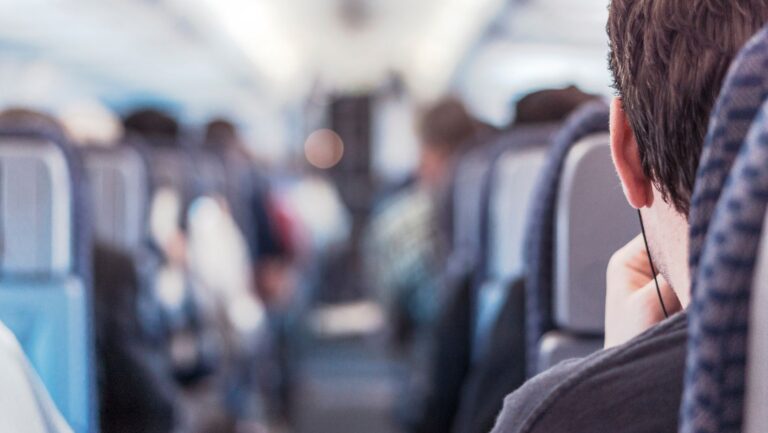Flying on an airplane is incredibly safe, but injuries can still happen from time to time. The good news is that generally, if someone does get hurt on a flight, the cabin crew is trained to respond swiftly to assess the situation and provide assistance.
So what exactly happens when a passenger or crew member sustains an injury while in the air?
Assessing the Injured Person
The first priority when an injury occurs is to conduct an initial evaluation of the person. A flight attendant will likely be the first responder on the scene. They will ask the injured passenger questions to understand what happened and determine the nature of the injury. The attendant will also check for responsiveness, breathing, pulse rate, skin signs, and more.
If it is a visible physical trauma, they will look for bleeding, bruising, deformity, burns, etc. This quick triage allows the crew to judge the severity, decide on the next steps, and request extra assistance if needed right away.
Providing First Aid Treatment
After a rapid primary assessment, the cabin crew will provide appropriate first aid care while in the air. All flight attendants are trained in basic emergency medical response and can assist passengers with common issues.
For minor injuries, the medical kit onboard has supplies like bandages, slings, braces, medications, eye wash, smelling salts, and more. The crew can clean and dress wounds, immobilize injured limbs, apply cold compresses, distribute over-the-counter drugs, and monitor patients.
Calling for Onboard Medical Volunteers
In addition to the flight attendants, planes often carry medical professionals as passengers. If the injury requires more advanced assistance, the cabin crew will page overhead asking if there is a “physician, nurse, EMT, paramedic or other medical personnel” onboard who can volunteer.
Usually, multiple people with training will come forward to help depending on the plane’s size. These Good Samaritans can provide their expert supplemental care until the plane lands or communicate needs to the crew.
Consulting with On-Call Doctors
All major airlines have an on-ground team of doctors and nurses available at every second for inflight emergencies. Planes now have wifi connections to the ground during flights. The attendants can call the medical team on the ground, describe a patient’s symptoms and condition, and receive guidance on how best to treat them. Having an experienced physician immediately available by phone is invaluable, especially when complex health events happen at 30,000 feet.
Upgrading Assistance with Onboard Medical Kits
If it is a significant injury or illness, the cabin crew can utilize enhanced emergency medical kits carried onboard. There are advanced tools like rigid cervical collars, saline IV fluids, injectable medications, suture kits, splints, automated external defibrillators (AEDs), and more. For example, if a passenger has a heart attack, they can use the AED to attempt to restart normal heart rhythms. The expanded equipment allows crews to handle more critical situations.
Diverting the Plane if Necessary
Typically, the highly-trained flight crew can manage inflight medical issues with assistance from volunteer healthcare providers and ground-based doctors. However, some extremely severe injuries or health events may require diverting the airplane. If the patient needs hospital-level care unavailable inflight, the pilots may decide to land early at the nearest suitable airport. Once on the ground, local EMS teams can board the plane and transport the injured passenger to a hospital. Although very rare, diverting is sometimes essential for the patient’s safety.
Filling Out Medical Incident Paperwork
Per regulations, the airline staff must document all onboard medical events, even minor ones. The attendants will gather key details about what happened, how the patient was cared for inflight, who assisted, and the outcome. After landing, they fill out lengthy paperwork describing the full timeline and submit it to their airline headquarters. The formal reports allow better tracking of inflight injury statistics over time so protocols can be improved.
Following Up After the Flight
Once a plane lands safely, an injured passenger will be escorted off first to receive prompt hospital care if not done earlier. In most cases, the airline will then follow up with the passenger in the next 1-2 days to check on their recovery status. The carrier may offer travel vouchers or miles as a goodwill gesture, especially if the patient complains or may consider legal action later. Staying in touch and showing concern after a turbulent health event can help reduce negative PR or lawsuits.
So in summary, the cabin crew is well prepared to handle inflight injuries and illnesses. With thorough emergency medical training, onboard medical resources, access to doctors on the ground, help from volunteer healthcare passengers, and established protocols, most medical issues at 30,000 feet can be treated promptly and appropriately.
Common Causes of Minor Injuries on Flights
While major medical emergencies are uncommon, minor injuries do regularly happen during air travel thanks to turbulence, slippery floors, and cramped quarters. Here are some of the most prevalent sources of cuts, bruises, sprains, and other bumps and scrapes passengers experience inflight:
Turbulence Injuries
Unexpected patches of turbulence are the leading cause of minor passenger injuries on planes. If the fasten seatbelt sign is not illuminated when the plane hits rough air, people can be tossed about violently in their seats. Turbulence can cause injuries by causing people to bang their heads, get flung into the ceiling, fall hard back into their chairs, or collide with nearby passengers and interior walls or furniture. Most turbulence injuries are superficial contusions, abrasions, and lacerations, but broken bones are also possible during extreme bouts.
Galley and Lavatory Falls
Between the small, cramped galleys where attendants prepare beverages and food and the tiny airplane lavatories, there are many tripping hazards. The confined spaces leave minimal room to maneuver. Combined with unexpected turbulence or slick, wet floors, falls are common. Passengers can lose their balance and take a tumble, resulting in bruises, scrapes, twisted ankles, and the like. Flight crews work hard to keep galleys and lavs clean and dry, but slips still routinely happen.
Heavy Carry-On Bags
Hauling overweight carry-on suitcases and bags into crowded overhead bins leads to many strains and pulled muscles during boarding and deplaning. The awkward angles required to lift cumbersome luggage above your head puts stress on shoulders, necks, and backs. And when bins are stuffed full on packed flights, people force heavy items into tight spaces, often causing injuries. Attendants may have to unload bins to retrieve medical kits for these mundane luggage overexertion wounds.
Seat and Seatbelt Issues
Today’s planes have smaller and smaller seats with less padding and legroom. On longer flights, the cramped quarters lead to body aches, loss of circulation, sore joints, stiffness, and other discomforts. Compression against armrests can cause nerve issues. Contorting oneself to access personal items under seats often leads to banged heads and scraped knees as well. Plus restrictive seatbelts required for safety reasons can rub and chafe skin over time. Flight crews distribute pillows, ice, bandages, and pain meds to help alleviate problems.
Dehydration and Motion Sickness
The low cabin humidity and pressure changes during flights can cause headaches, nausea, fatigue, and wooziness. Passengers who forget to hydrate adequately often feel faint or dizzy mid-flight as well. And some people suffer motion sickness from the plane’s movement and turbulence which makes them queasy. The medical kits have airsickness bags, oxygen, electrolyte beverages, aspirin, and other items to help treat dehydration and motion issues inflight before they become severe.
So while catastrophic mid-air emergencies grab headlines, minor first aid level injuries are actually much more prevalent during air travel thanks to the cramped cabin environment and turbulence issues.
How Can Passengers Help in Inflight Medical Emergencies?
Hopefully, you never encounter a significant medical crisis inflight either personally or with a fellow passenger. But if you get injured, you can read more about the steps to take after getting hurt on an airplane. And if you are not personally injured and someone else is injured, there are constructive ways travelers can assist the flight crew if called upon or volunteer to. Being an extra set of helpful hands and following instructions is the best approach.
Here is how you, as a passenger, can help manage tricky inflight medical situations:
Clear Space and Provide Privacy
If someone near you gets seriously ill or hurt, help the crew clear chairs, luggage, carts, and other obstructions from around them. Discreetly hold up blankets or clothing to give the patient visual privacy if they need medical assessments or treatments in the aisle or their seat.
Share Professional Skills
If you happen to be a doctor, nurse, EMT, paramedic, or other clinician, make sure to let the attendants know immediately. Provide your expert input on the patient’s condition or best next protocols based on training and experience. Clarify you are offering helpful advice rather than assuming formal care responsibility.
Follow Crew Instructions
Listen closely and comply with flight attendant requests about retrieving equipment from bins, notifying pilots, keeping aisles clear, returning to assigned seats, turning off electronic devices, and other operational instructions needed to ensure everyone’s safety.
Provide Relevant Patient Details
If you witnessed what happened to cause a neighbor’s distress or know vital background details about them (e.g. preexisting conditions), discreetly share potentially relevant information with the cabin crew responding. Every piece of data can help assess what is happening.
Remain Calm and Reassuring
It can be very stressful for affected passengers and families to endure medical scares in confined public spaces. If possible, politely offer kind words of comfort and encouragement. And stay calmly in your seat unless asked to assist so as not to alarm others or get underfoot.
Give Space When Needed
Be cooperative about changing seats or tolerating minor inconveniences like blocked lavatories if necessary. Making sufficient room for providers to supply emergency care is the top priority, even if temporarily uncomfortable.
While professional crews have the ultimate responsibility of running inflight medical events, compassionate passengers can positively contribute as well with emotional support, information sharing, and following instructions.






